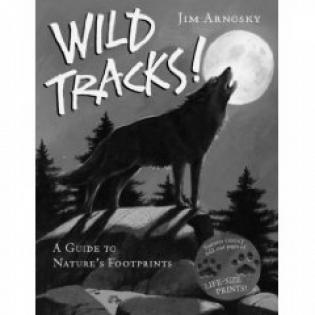Wild Tracks! Literature Guide
What do you leave behind when you walk through the woods? Hopefully only tracks of your footprints. In this book, Jim Arnosky guides readers to learn the language of animal tracks. We learn about the behavior and personalities of a variety of animals simply by studying their tracks. Through comparison of shape, pattern, and size, we admire the beauty and complexity of nature. This nonfiction text inspires and feeds the young naturalist.
Before Reading
ASK: What animal tracks have you seen in the woods? How big were they? Did you like seeing them?
SHOW: Look at the cover. We probably won’t get to see a wolf or other wild animals in the woods, but what evidence do you think we might see or hear of them?
CONNECT: Have you ever heard a wolf howl? What does it sound like?
During Reading
ASK: What are the smallest tracks you can find in the book? What are the biggest tracks? Which tracks are the most unusual?
SHOW: Look at the deer tracks (page 9). Read about the dewclaws and find the tracks that show dewclaws. Compare the running tracks to the walking tracks.
CONNECT: Do you think your tracks look different when you are running than when you are walking? Do you think your tracks look different from a friend’s?
After Reading
ASK: What do you think animals would think if they knew people were studying their tracks?
SHOW: Look at the artist’s technique to show depth and texture. Talk about how color and shading make some parts of the track look deeper than others.
CONNECT: Find the tracks in the book that are familiar as something you might find in your area. Talk about that animal’s habits—what time of day are they out, where do they live, what do they eat, how they act around humans, etc.
Activities
-
Go for a walk in the woods, near a pond, or in another natural area. Bring a sketchbook and look for tracks to draw. Try to guess which animal made the tracks.
-
Read more about some of your favorite animals in this book.
-
Discuss ways we can respect the homes of animals. What can we do to make humans more aware of the needs of wild animals?
-
Make a poster about one animal from this book. Write facts about the animal and include pictures of its habitat and tracks. Write a sentence that encourages people to show respect for the needs of animals.
-
Choose two animals from different families whose tracks have a very different shape, but whose patterns are similar. Draw the sets of tracks side-by-side and compare the similarities and differences.
-
Draw a set of human tracks next to a set of animal tracks and write about how humans and animals can live side-by-side without harming each other.
-
Go to a nature center and learn about local wildlife and habitats.
-
Make a promise to take care of all your garbage and recycling in order to do your part to keep the earth as natural as possible for the wildlife.
